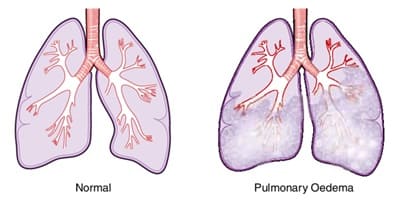Home › Information about Scuba › Diving Injuries › IPE
Immersion Pulmonary Edema
IPE refers to a condition caused by an accumulation of fluid in the lungs (alveoli) that occurs more often in surface swimmers (e.g. SIPE) and in scuba divers as they get older.
This help guide explains some of the risk factors associated with being immersed in water, the typical symptoms of internal drowning, and how best to treat it.
What Causes Immersion Pulmonary Edema
The risk of IPE (also known as IPO) increases with age and with certain age-related health changes.
For the most part, the condition occurs most often with older divers. It also appears to be associated with:
- Breathing from a scuba regulator
- Heart conditions (when immersed in a cold water environment)
- Sea water aspiration
- Taking beta blocker medication
Pro Tip: IPE symptoms can also manifest themselves as swimming-induced pulmonary edema (SIPE) - which may be fatal in severe cases. As a result, the condition can occur in swimmers and scuba divers who are young and in general good health.
What is Immersion Pulmonary Oedema in Diving?
IPE is the medical term for a condition that shows up as an accumulation of fluid (usually sea water) inside the air-filled sacs of the lungs (called alveoli). Hence, scuba divers and surface swimmers can get IPE when they immerse themselves in water.
Why?
If the fluid pressure in the surrounding capillaries is greater than the pressure inside the alveoli, it can "seep" into the cluster of air-filled sacs.
Even so, having some fluid in each alveolus is normal and healthy for most people. But, too much of it can obstruct the breathing mechanism and cause any (or all) of the following ailments:
- Chest pain
- Dyspnea (difficulty breathing)
- Frothy pink sputum
By and large, the typical symptoms of IPE tend to improve soon after you get out of the water and resume normal breathing. Nonetheless, advanced medical interventions may be necessary in certain advanced cases where further complications are present.
What Factors Increase the Risk of IPE?
When combined with underwater immersion, such as when using a scuba regulator, certain factors may aggravate, or increase, the likelihood of suffering a pulmonary edema.
For example, being exposed to cold water tends to exacerbate the shifting of body fluids to the chest. Other types of medical conditions that can also increase the risk of IPE include:
- Breathing an inappropriate gas mix (especially at depth).
- Cardiac failure and certain kinds of genetic susceptibilities or genetic disorders.
- Congenital heart conditions (e.g. left-ventricular hypertrophy) and hypertension (high blood pressure).
- Drinking too much water (a condition called overhydration).
- High-intensity exercise (e.g. before or during the dive) or heavy breathing (e.g. due to airway restrictions caused by the scuba equipment).
Important: There are several ways scuba divers can reduce the risk of getting Immersion Pulmonary Oedema (IPO). Always wear appropriate thermal protection, avoid overexertion in the water, and address any potential health-related risk factors for diving - especially elderly divers.
Immersion Pulmonary Edema Symptoms
 Coughing (sometimes there will be blood-tinged, frothy sputum in the airways)
Coughing (sometimes there will be blood-tinged, frothy sputum in the airways)- Hemoptysis (expectoration of blood from the lower respiratory tract)
- Hypoxemia (lack of oxygen)
- Shallow, rapid breathing
- Shortness of breath (dyspnea)
- Unconsciousness (absence of normal breathing)
Pro Tip: A physician should address any IPE symptoms caused by an underlying cardiac issue. The Divers Alert Network recommends waiting at least one (1) month before diving after Immersion Pulmonary Edema.
Immersion Pulmonary Edema Treatment
Do not delay ending the dive if you have any of the signs and symptoms consistent with internal drowning. Exit the water as soon as it is safe to do so and seek medical attention.
In other words, you can make a controlled ascent if there are no severe complications underwater. But, you should make a direct ascent if the symptoms worsen or you are finding it difficult to breathe.
Even if the symptoms start to improve, a scuba diver or swimmer that is showing symptoms of IPE, should:
- Be checked for consciousness, open airway, and normal breathing (begin resuscitation where necessary).
- Receive one hundred percent oxygen as soon as possible (preferably via a constant flow delivery system).
- Be evaluated by a medical professional and receive Immersion Pulmonary Edema medications (e.g. call an ambulance if appropriate).
Pro Tip: The main section contains detailed information about scuba diving injuries and how to initiate the proper first aid response after alerting the local emergency services.
Related Information and Help Guides
- Decompression Sickness Symptoms and Best Treatment
- Drowning and Near Drowning Symptoms with Evaluation Procedures
- First Aid Treatment for Hyperthermia Heat Injury
- How to Recognise the Typical Signs of Shock?
- What is Pelagism: Common Causes of Seasickness for Divers
Note: The short video [presented by DAN Southern Africa] contains important information about common predispositions to IPE (internal drowning).